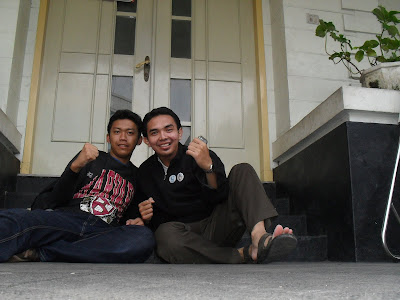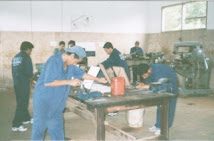Sabtu, 24 September 2011
Opening Speech by Minister of Research and Technology, Republic of Indonesia On the First Indonesian-American Kavli Frontiers of Science Symposium
Minggu, 18 September 2011
Nanoteknologi

Nanoelectronics refer to the use of nanotechnology on electronic components, especially transistors. Although the term nanotechnology is generally defined as utilizing technology less than 100 nm in size, nanoelectronics often refer to transistor devices that are so small that inter-atomic interactions and quantum mechanical properties need to be studied extensively. As a result, present transistors do not fall under this category, even though these devices are manufactured with 45 nm or 32 nm technology.
Nanoelectronics are sometimes considered as disruptive technology because present candidates are significantly different from traditional transistors. Some of these candidates include: hybrid molecular/semiconductor electronics, one dimensional nanotubes/nanowires, or advanced molecular electronics.
Although all of these hold promise for the future, they are still under development and will most likely not be used for manufacturing any time soon.
Part of a series of articles on Nanoelectronics | |
| Single-molecule electronics | |
| Solid state nanoelectronics | |
| Related approaches | |
| See also | |
Contents |
Fundamental concepts
The volume of an object decreases as the third power of its linear dimensions, but the surface area only decreases as its second power. This somewhat subtle and unavoidable principle has huge ramifications. For example the power of a drill (or any other machine) is proportional to the volume, while the friction of the drill's bearings and gears is proportional to their surface area. For a normal-sized drill, the power of the device is enough to handily overcome any friction. However, scaling its length down by a factor of 1000, for example, decreases its power by 10003 (a factor of a billion) while reducing the friction by only 10002 (a factor of "only" a million). Proportionally it has 1000 times less power per unit friction than the original drill. If the original friction-to-power ratio was, say, 1%, that implies the smaller drill will have 10 times as much friction as power. The drill is useless.
For this reason, while super-miniature electronic integrated circuits are fully functional, the same technology cannot be used to make working mechanical devices beyond the scales where frictional forces start to exceed the available power. So even though you may see microphotographs of delicately etched silicon gears, such devices are currently little more than curiosities with limited real world applications, for example, in moving mirrors and shutters [1]. Surface tension increases in much the same way, thus magnifying the tendency for very small objects to stick together. This could possibly make any kind of "micro factory" impractical: even if robotic arms and hands could be scaled down, anything they pick up will tend to be impossible to put down. The above being said, molecular evolution has resulted in working cilia, flagella, muscle fibers and rotary motors in aqueous environments, all on the nanoscale. These machines exploit the increased frictional forces found at the micro or nanoscale. Unlike a paddle or a propeller which depends on normal frictional forces (the frictional forces perpendicular to the surface) to achieve propulsion, cilia develop motion from the exaggerated drag or laminar forces (frictional forces parallel to the surface) present at micro and nano dimensions. To build meaningful "machines" at the nanoscale, the relevant forces need to be considered. We are faced with the development and design of intrinsically pertinent machines rather than the simple reproductions of macroscopic ones.
All scaling issues therefore need to be assessed thoroughly when evaluating nanotechnology for practical applications.
Jumat, 16 September 2011
Nuklir Indonesia
Masyarakat Nuklir Indonesia
Indonesian Nuclear Society
The Indonesian Nuclear Society was launched in the mid-1960s,
(when first reactor in Indonesia launched [Triga Mark II at Bandung] a time of growing interest in employing peaceful applications of nuclear science and technology for bettering the lives of people in the Indonesian and around the world.
Visi
Pendukung dan Pengembang Program IPTEK Nuklir untuk Perdamaian di Indonesia
18 Reaktor Nuklir Indonesia tahun 2040
Tersedianya sarana pendamping disetiap reaktor
1. Pusat Pendidikan dan Latihan
2. Pusat Inovasi, Penelitian dan Pengembangan
Misi
1. Wahana Edukasi masyarakat mengenai IPTEK Nuklir
2. Sarana penampung aspirasi masyarakat mengenai IPTEK Nuklir
Program
1. Pertemuan Rutin Pertahun
2. Publikasi dan Edukasi Masyarakat
Fokus
5 Tahun Pertama
(2010-2015)
5 Tahun Kedua
(2015-2020)
5 Tahun Ketiga
(2020-2025)
5 Tahun Keempat
(2025-2030)
5 Tahun Kelima
(2030-2035)
5 Tahun Keenam
KESEHATAN & OBAT-OBATAN
In nuclear medicine procedures, elemental radionuclides are combined with other elements to form chemical compounds, or else combined with existingpharmaceutical compounds, to form radiopharmaceuticals. These radiopharmaceuticals, once administered to the patient, can localize to specific organs or cellular receptors. This property of radiopharmaceuticals allows nuclear medicine the ability to image the extent of a disease-process in the body, based on the cellular function and physiology, rather than relying on physical changes in the tissue anatomy. In some diseases nuclear medicine studies can identify medical problems at an earlier stage than other diagnostic tests.
Treatment of diseased tissue, based on metabolism or uptake or binding of a particular ligand, may also be accomplished, similar to other areas of pharmacology. However, the treatment effects of radiopharmaceuticals rely on the tissue-destructive power of short-range ionizing radiation.
In the future, nuclear medicine may provide added impetus to the field known as molecular medicine. As our understanding of biological processes in the cells of living organism expands, specific probes can be developed to allow visualization, characterization, and quantification of biologic processes at the cellular and subcellular levels.[1] Nuclear medicine is an ideal specialty to adapt to the new discipline of molecular medicine, because of its emphasis on function and its utilization of imaging agents that are specific for a particular disease process.
  |
  |
 |
 |
  |
List of Radiopharmaceuticals Tabel Bermacam Radiofarmaka | |
|---|---|
| Radiopharmaceutical Kits Kit Radiofarmaka | Application Kegunaan |
MIBI Kit | Myocardial perfusion diagnosis |
MAG-3 Kit | Kidney filtration diagnosis |
HMPAO Kit | Celebral blood flow diagnosis |
HYNIC-UBI Kit | Cancer diagnosis |
HYNIC-TOC Kit | Infection diagnosis |
153Sm-EDTMP Solution | Bone cancer palliative theraphy |
153Sm-particulates | Theraphy for rheumatoid arthritis |
131I-MIBG | Theraphy for neuroblastoma |
131I-LipidolSolution | Hepatoma therapy |
186Re-HEDPSolution | Bone cancer palliative therapy |
RIA Kit Hepatitis B | Hepatitis B, HbsAg and anti Hbs detection |
RIA Kit Hepatitis C | Hepatitis C detection |
RIA KitT3, T4, TSH | Thyroid function detection |
RIA Kit Mikro albuminuria | Heart failure early detection |
RIA Kit Progesteron | cattle fertility detection |
IRMA Kit AFP & CEA | Diagnosis for tumor of the breast and digestive tract |
Further reading
- Mas JC: A Patient's Guide to Nuclear Medicine Procedures: English-Spanish. Society of Nuclear Medicine, 2008. ISBN 978-0972647892
- Taylor A, Schuster DM, Naomi Alazraki N: A Clinicians' Guide to Nuclear Medicine, 2nd edition. Society of Nuclear Medicine, 2000. ISBN 978-0932004727
- Mark J. Shumate MJ, Kooby DA, Alazraki NP: A Clinician's Guide to Nuclear Oncology: Practical Molecular Imaging and Radionuclide Therapies. Society of Nuclear Medicine, January 2007. ISBN 978-0972647885
- Ell P, Gambhir S: Nuclear Medicine in Clinical Diagnosis and Treatment. Churchill Livingstone, 2004. (1950 pages) ISBN 978-0443073120









